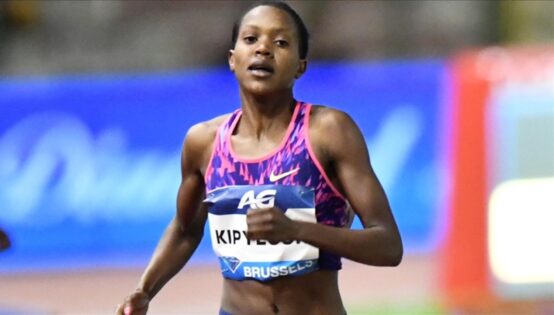For nearly seven decades, the four-minute mile has stood as a boundary so imposing that only the bravest among runners have dared to test its reach. When Faith Kipyegon walked onto the track in Paris under the fading evening light, she did not merely approach it. She aimed to dismantle it. This was no ordinary record attempt. It was a declaration of ambition against the most forbidding arithmetic in middle-distance history.
Prior to that moment, Kipyegon’s stride mirrored quiet precision. She moved behind pacers with studied rhythm, clocking 400 metres in 60.20 seconds and 800 in 2:00.75. There was no visible strain, only a practiced economy of movement. But by the 1200-metre mark, where she registered 3:01.84, the effort began to tell. The margin was growing slender. She was no longer racing time alone. She was now also racing physiology, friction, and breath.
Her final 409 metres, though resolute, did not yield the outcome she had plotted. She crossed the finish line in 4:06.42. Faster than her official world record of 4:07.64, yet still beyond the sub-four-minute target. And although the result will not stand in the books due to regulated equipment standards and time-trial pacing support, the performance itself defied conventional framing. This was not an exhibition. It was a direct address to posterity. “I’m so grateful to have proven to the world that everything is possible,” she said, steady in tone, “I have proven that something special is coming… Yeah, I know one day, one time, a woman will run under four. I will not lose hope, I will still go for it. And if there’s not something like this, a special one, I think she’s not Moldova, Moldova or anything, 1 will still go for it. And I hope I will get it one day, one time.” The structure of the evening had been constructed to maximize her odds.
Nike’s ‘Breaking4’ campaign, previously associated with men’s marathon attempts, lent its full resources to Kipyegon’s effort, bespoke spikes, hand-selected pacers, and a tailored race kit, among other provisions. The attempt may not have unfolded within the jurisdiction of record eligibility, but it certainly functioned as a credible rehearsal for future official challenges. What mattered more, however, was the visible narrowing of the impossible.
Paris 2024 Olympics – Athletics – Women’s 1500m Semi-Final 1 – Stade de France, Saint-Denis, France – August 08, 2024. Elle Faith Kipyegon of Kenya react after winning the race. REUTERS/Sarah Meyssonnier
When Roger Bannister broke four minutes in 1954, he shattered an imaginary ceiling. Yet no one realistically extended that same possibility to women’s middle-distance running. Until Kipyegon. The Kenyan has now authored seven of the ten fastest 1500-metre races in history, and with tonight’s run, she claims another distinction: the fastest mile ever run by a woman under any circumstances. Whether or not this race appears in formal archives, it has permanently altered the expectations of what a woman can achieve on the track.
In that sense, the finish line was not an end. It was a continuation. The sub-four mile remains intact for now, but its perimeter is no longer untouched. Faith Kipyegon has brought it into reach. And her attempt was so historic, that she got the medicine experts talking.
Faith Kipyegon’s sub-four bid challenges science, not just history
In the precise language of performance science, there is little room for mythology. And yet, as Faith Kipyegon prepares to challenge the four-minute mile, one of the most hallowed barriers in athletics, experts like Dr. Emily Kraus see more than biomechanics at play. As director of the FASTR Program at Stanford, Kraus regards this effort not merely as a personal trial of pace, but as a public recalibration of what the female athlete is presumed capable of achieving.
“There’s an incredible spotlight on women in sport and what’s truly possible,” Kraus remarked, placing Kipyegon’s pursuit in direct conversation with the long history of neglect in female athletic research. In recent decades, women’s running has contended not just with physiological constraints but with structural ones, delayed access to high-level coaching, limited investment in female-specific gear, and research pipelines overwhelmingly tailored to male subjects. Kraus sees Kipyegon’s run as an act of practical challenge to those omissions. The sub-four attempt is not only about distance and speed but about returning the long-ignored variables of women’s sport, hormonal cycles, running economy, and tactical nuance, into serious scientific consideration.
The mechanics of such a feat are forbidding. Shaving over three percent off an already staggering world record, Kraus notes, would require “perfect conditions, pacing, physiology, and technology.” Her analysis isolates each element with clinical precision, aerodynamic drag trimmed by pacers, muscle-tendon stiffness honed through elite training, and marginal gains delivered by super shoes and laser-guided pacing. But behind this rigor lies a larger assertion. Faith Kipyegon’s race may very well signal not the outer limit of possibility, but the overdue recalibration of it.
The post Faith Kipyegon Breaks Silence After Sub-4 Mile Bid Falls Short: ‘I Will Not Lose Hope’ appeared first on EssentiallySports.
